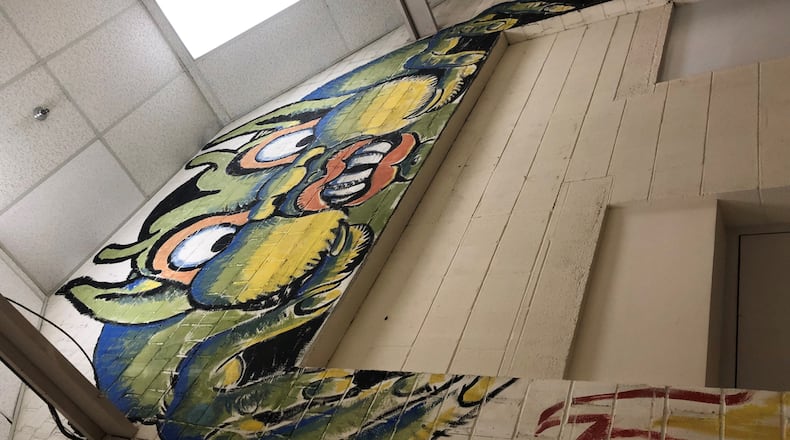But artwork by German prisoners of war once held in Dayton shows a different side of the soldiers in a story that could be lost if the art is not preserved.
Their paintings of green creatures came into existence in or around 1943, the result of a group of German POWs who were held in Dayton after camps in Europe grew full. Records are absent, leading to more questions.
The POWs were thought to be non-commissioned officers.
In 1984, Louis Walker, then with the Air Force Material Command Office of History, interviewed Florence Paxton, a WWII vet who had served when the POWs were held at the Dayton base.
Paxton said they were young, around 20, friendly and apparently glad to be away from bombs and destruction.
Heavily guarded, they were put to work on the grounds, with little free time. Yet in that spare time, she said, they sang, played piano and painted these odd creatures that have survived to this day. Three sets of paintings originally existed. Two were dividing walls that were lost in 1952, either removed or destroyed, but lost forever.
The wall that remains is in Building 280 and covers a back wall in a long-used warehouse.
The paintings are green, blue and red, with brushstrokes that show skill and patience. The figures are cartoonish, reminiscent of the Germanic trolls found in doodles in manuscripts going back to the Dark Ages monasteries.
The only name of the POWs Florence remembered was a Herbert Pabst of Saxony, Germany, but he was never successfully contacted to verify the claim. This is likely due to this being in Russian territory post war.
Pabst would have come of age in the Third Reich, been captured, placed under guard and then ordered to do groundwork in Dayton in a makeshift POW camp.
It isn’t possible to know what a mind experiences in a moment like that. Yet, it is that mind that painted children’s cartoon trolls after 18-hour days on duty. One suggestion is that the POWs might have been processing the events of their lives, and in the process, turning to a vision of innocence, peace and the stories that might mark better days. For these are benign creatures, and even poke fun.
The Norse figure Alviss was promised the daughter of Odin but was fooled by Loki and Thor. A figure from one of the better-known stories of Norse mythology, and it is now gracing the walls of Building 280 at Wright-Patterson Air Force Base.
The future of the historical location remains in question.
The Green Men of Wright-Patt were given a Department of Defense legacy grant in the 1980s. That allowed the paintings to be stabilized by McKay Lodge Fine Arts in Oberlin.
The wall currently is near the Office of History, so the paintings are being watched for damage. However, the building is slated for renovation or replacement due to its age, and a new home for the artwork will be needed.
In the past the National Museum of the United States Air Force and the Dayton Art Institute were contacted about the wall, and Aviation Trail Inc. considered moving the wall into a turn-of-the-century theater the group purchased for renovation as well.
The size of the works means that wherever they end up, they will need space. They are 60 x 20 feet.
When the two other walls of artwork were lost in 1952, then-commander Brig. Gen. Joseph T. Morris was reported to be upset, even trying to save it too late.
It remains to be seen if history will repeat itself or if the remaining works will be preserved.
Kathleen Caffrey is a member of the Dayton Journalism Lab.
About the Author

